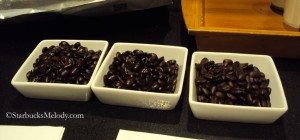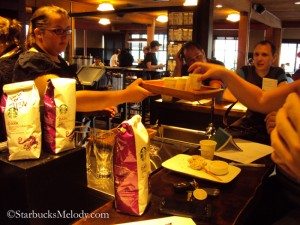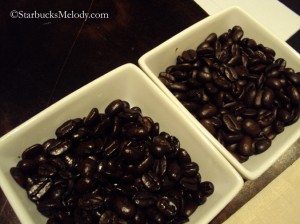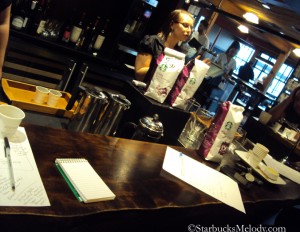 The most recent coffee tasting at the Olive Way Starbucks was an exercise in comparing beans from a freshly-opened bag with stale beans. It was a very interesting experience, and I recommend trying this. If you’ve ever wondered if that bag of coffee that has been sitting on your shelf for two weeks is still good, you’ll now know that the answer is firmly “no.” We compared beans from three different bags of coffee. They were all the Komodo Dragon Blend, and all prepared via a French press.
The most recent coffee tasting at the Olive Way Starbucks was an exercise in comparing beans from a freshly-opened bag with stale beans. It was a very interesting experience, and I recommend trying this. If you’ve ever wondered if that bag of coffee that has been sitting on your shelf for two weeks is still good, you’ll now know that the answer is firmly “no.” We compared beans from three different bags of coffee. They were all the Komodo Dragon Blend, and all prepared via a French press.
The three Komodo Dragon bags:
- Fresh: One bag was freshly opened right before grinding and brewing the coffee.
- Stale: One bag had been opened two weeks before the coffee seminar on August 13, 2012, and simply stored in the back room of the Olive Way Starbucks.
- Frozen: The third bag had been opened about eight days before the coffee seminar, and stored for all eight days in a freezer.
The important takeaway from this event was that freshness matters! Use your coffee within seven days of opening up the bag. Do not store it in your freezer. Starbucks recommends that you store your coffee in an air-tight container, away from light and moisture. A ceramic container with a nice seal may be perfect for storing your coffee.
One could even simply glance at the three sets of coffee beans all side by side, and easily see a difference in them:
By the way, there was a pretty good audience in attendance for this seminar. It seems like Olive Way has built up a regular audience of partners and customers who want to experience their coffee tastings. If you want to attend a coffee tasting, they are every other Monday evening, at 6:00 p.m. They are free to attend! Call ahead and confirm the schedule:
Olive Way Starbucks
1600 East Olive Way
Seattle, WA 98102
206-568-5185
The famous Mikey joined in this coffee tasting. You might recognize Mikey from the window cling found on every company-operated Starbucks in the United States. Look for the window cling that says, “Opportunity.”
Back to the coffee tasting:
Just as a reminder, the four steps of a Starbucks coffee tasting are as follows:
- Smell – Take a good sniff and smell the aroma.
- Slurp – Once the coffee has cooled to a drinking temperature, take a large slurp of it, aerating and spraying it all over your mouth.
- Locate – Make a note of where the flavors hit in your mouth? Do you taste this coffee on the sides of your mouth? In the front? In the back?
- Describe – Describe the coffee flavors.
For some of my thoughts on elements of a good coffee tasting, take a look at “Melody’s top 10 coffee tasting tips” article.
Thank you to Megan and Jess, the two coffee masters who put this event together! Here’s the coffee tasting in full swing, with Megan passing sample cups to the attendees:
Fresh:
The freshly-opened Komodo Dragon beans had a complex aroma with lots of maple, cinnamon, and spice notes. The coffee was beautifully smooth, with a sweetness to it, and a large bold flavor. I tasted a lot of cinnamon in the fresh Komodo Dragon. It’s a low acidity coffee, and I tasted it all over my mouth.
Frozen:
One thing that was remarkable about the beans that were frozen was that they had lost all their aroma. I could not detect any aroma at all. It was simply all gone. This makes for a terrible cup of coffee. The customer sitting to my right blurted out, “This tastes like crap!” The coffee had managed to acquire a very bitter aftertaste also.
Roasted coffee beans are very porous. They will indeed easily absorb flavors. If you think about a flavored coffee, such as a hazelnut flavored coffee bean, one reason it is easy to produce such a product is because beans are porous. Beans stored in a freezer might pick up flavors of other items in the freezer, such as fish or meats!
Stale:
The stale coffee looked the worst of the three bags of coffee, by a long shot. Comparing the freshly-opened coffee with the two-week old coffee beans, one can see a clear difference in the beans. The stale coffee bean has lost its shine! Oddly, the coffee still had a very slight aroma. The aroma was flat and blunted, but still had a very slight spicy note to it but seemed to also be a little salty too. The brewed stale coffee had lost its smoothness, and also had a bitter bite to it. Take a look at the fresh beans side by side with the two-week old stale beans:
When the coffee tasting was all over, we checked the back of the Komodo Dragon bags to make sure that they all had similar expiration dates, as that could possibly affect the results. Sure enough, all three bags were within a couple of weeks of each other in terms of their expiration dates.
Last but not least, we paired a French press of the fresh and good Komodo Dragon with the Rosemary Brown Sugar Cashews, which are part of the Evenings food menu. That was a really great pairing and brought out a lot of the savoriness to the coffee.
The bottom line is use your coffee beans within 7 days of opening up the bag!
Jess winds down the event, reminding everyone about the importance of fresh coffee and proper bean storage:
Thank you again coffee masters Jess and Megan! I thoroughly enjoyed this seminar! This truly brought home the importance of whole bean storage! If you want to follow Olive Way on Twitter, follow @GayleOnOlive.
If you like reading about coffee tastings, click through the coffee tastings category for many more articles.
Related posts
19 Comments
Leave a Reply Cancel reply
You must be logged in to post a comment.
Sponsors
Recent Comments
- DEVIN on Compostable Straws Land in Seattle Starbucks Stores
- coffeebeanz on Why do you go to Starbucks less often? (If that’s true for you)
- Willi on You can now buy a Siren statue: $6,000
- Willi on A major revamp of your drink recipe: Testing syrup extracts and cane sugar
- Skip on Why do you go to Starbucks less often? (If that’s true for you)











What a great educational experience! Amazing.
Interestingly, I’ve had a few instances where beans I bought at a local chain megastore had no “shine” on opening and i noticed the taste difference. Made me switch back to buying direct from my local Starbucks almost exclusively.
As always, thanks for sharing your experiences.
Melody this is a very interesting piece on coffee tastings and the quality of the beans. I have gone back and forth re where to put coffee beans. This Olive Way store and their partners continue to impress me.
VERY interesting take on a coffee tasting!
I’ve been wanting to do a tasting similar to this! I think it’s very important that customers (and Partners!!) understand the importance of coffee freshness. It changes the entire coffee experience!
Thanks for this post, Melody!
Great public service announcement about NOT FREEZING coffee. I have told my friends this and they still don’t believe me and they think it stays fresher in the freezer.
😉
Maybe we can all convince Melody to track down where the storing coffee beans in the freezer myth originated!
Thanks for a great post Melody – and I agree with @Purple1 – the partners at Olive Way are truly exceptional.
Another great article Mel. I really think that freshness gets overlooked too much as people think that because it’s not ground it’s ok. Thank you for bringing it to light in your blog. And the dangers of freezing coffee.
Just an observation on one of the other comments – just be careful not to link the shininess of the beans with them being stale. A lighter roasted coffee wont necessarily draw out the oils. Compare something like Breakfast Blend with Komodo. Komodo is very shiny/oily but Breakfast Blend not so!
Lastly – although a great tasting, how could the store use Komodo Dragon for the test. It’s such a great coffee. Maybe it’s because we cant get it in the UK that it seems such a shame to let it go stale!
@Laurence W – Hey I didn’t realize that the UK market doesn’t get Komodo Dragon! I should put some in the mail to you. 🙂 You bring out a great point about the color of the beans (you’re a true coffee master! StarbucksUK is lucky to have you). And interestingly, and perhaps I should have made this more clear: The “stale” (2 week old) beans LOOKED the worst, but the “frozen” beans TASTED the worst!
@Everyone – Olive Way should be extremely proud of their commitment to coffee education. Having been writing a blog for years, I can say for sure that many times I hear partners say, “Our store is going to be doing regular coffee tastings.” And then nothing happens. It takes an ENORMOUS amount of motivation to 1) schedule it 2) get partners consistently involved 3) market it 4) and get a regular audience. This sounds much easier said than done! Right now, I can only think of a handful of Starbucks that have any kind of regular coffee tastings. At this point, Olive Way represents the face of Starbucks coffee seminars.
Great post Melody!
Mikey is famous in Canada too! Once I was in a Seattle store and the girl serving me was in one of the old training videos that I used to teach seminars. I was a little “starstruck” and kindof surprised it was a real barista.
I’m also impressed with the turnouts for the coffee tastings. I think having a regular time would really help. I’m going to have to talk to my coffee master Nathan about this. How long are the sessions?
@Lawrence We chose Komodo for exactly that reason. It’s a complex, aromatic, flavorful coffee. We anticipated how it would change over time and wanted to highlight the extreme loss in quality. I hear you about the waste, but if we all learn something important, and Melody blogs about it, then MORE people learn! It’s all for the sake of knowledge! 🙂
@Becca Each seminar varies. We plan for 30-45 min of material. Discussions and conversation add time and quality. Any teacher will know a lesson always takes longer than you anticipate so plan for that! Happy to be a resource. Follow us on Twitter or call the store. Would love to help bring this to more customers!
Super interesting article. I’ve opened other brands of coffee beans and found that they looked dried out – like the 2 week old beans in your picture. I noticed when I made some that it didn’t have as much flavor as SB coffee. Thinking it was just the way they roasted it, I just used it up, but probably won’t buy it again. I always love opening a bag of beans and the oils in the coffee make the beans glisten and the aroma is amazing. FRESH!
Sounds like another great seminar. And it’s absolutely true – freshness DOES matter.
Great post Melody. I am a coffee master in the Princeton, WV location and am definitely going to steal this coffee comparison tasting for my partners and customers. I would have never thought of doing this. Thanks for always sharing and let the ladies in the Olive Way Store know they rock.
Hi Molly – We dark roast lovers smile at a sheen of oil on coffee! 🙂
@Kevin and Nathan – If you do a coffee tasting like this in your store, I want to hear about it! And aint that the truth – Megan and Jess rock!
I’m glad so many enjoyed reading about this coffee tasting. There really have been so many amazing coffee events at the Olive Way Starbucks.
Now, this is a very well thought out post. I never really thought about frozen coffee beans and what you said about them losing aroma, sort of surprised me. Thanks for the insight, it sure is nice to see some of these things pointed out with images!
Wow! We have a small Starbucks joint in the town where I live and I am a regular visitor there. I simply love Coffee, but they never really had a Coffee tasting sessions ever! I need to inquire as I have never been to any coffee tasting sessions and I am sure it must be quite an experience!
Was there any discussion about what the best option is if you can’t finish a pound of coffee in a week? On a “heavy” coffee-drinking week I might come close to drinking half a pound of coffee. I’ve tried a Friis coffee storage container and it helps, but there’s still a noticeable degradation in flavor after a week or two.
@Jason,
I would suggest buying only a quarter or half pound of coffee at a time. Any Starbucks can sell you a half or quarter pound of any coffee you’d like.
Jason, a couple of years ago we sold some coffee to a customer who wanted most ground but needed a specific number of beans left intact. In that it was an odd request I asked why. The were soaking the beans in vodka to make coffee flavoured vodka. I did not hear how it turned out, but there’s sn option for your extra beans! 🙂